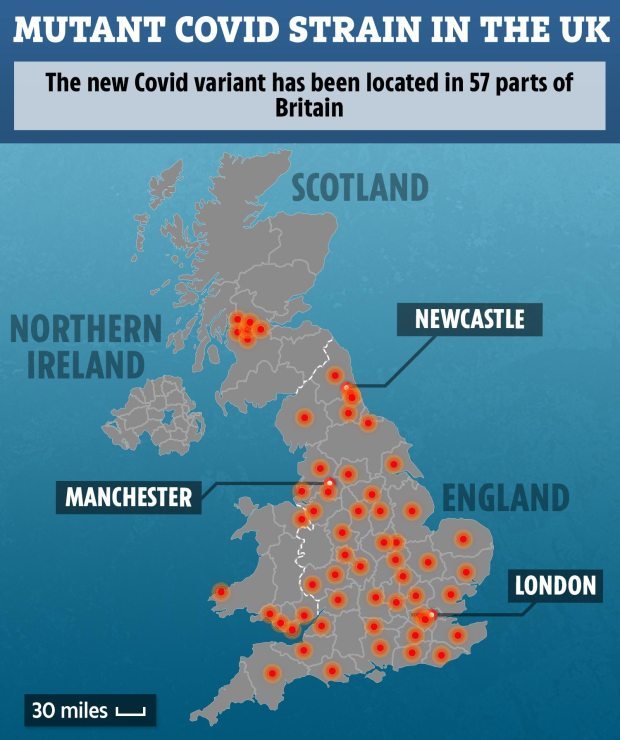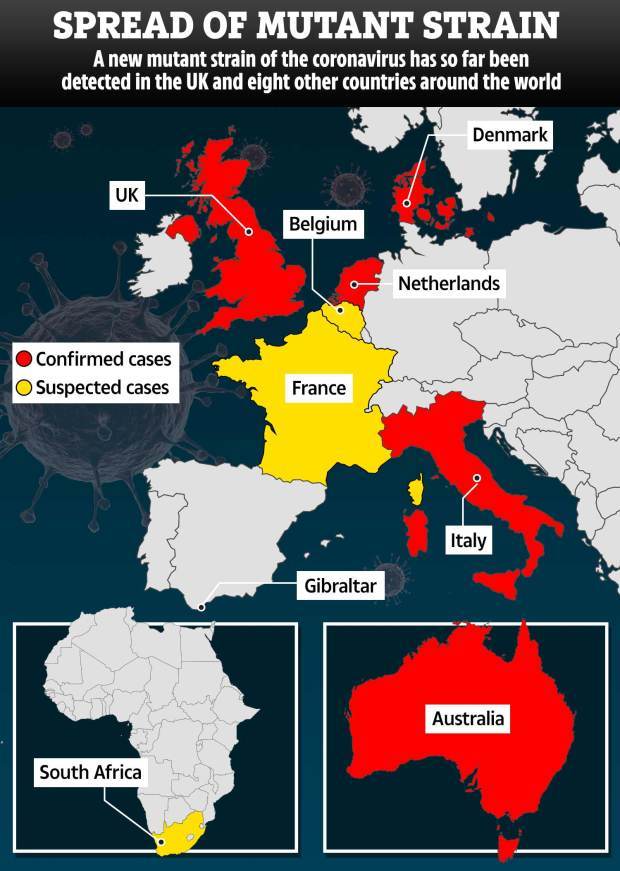THE new strain of Covid most likely evolved in one patient in Kent, scientists believe.
And they fear the variant gripping the UK is the cause of “explosive” outbreaks of cases in schools and care homes.


It comes amid claims the new variant has a better ability to infect children than before, which would make the opening of schools a problem, scientists said.
NERVTAG – which have been analysing the new strain – discussed their findings virtually with the Science and Technology Committee today.
They discussed:
- If children are more able to spread the virus, as data suggests, it would have an impact on how we control Covid-19
- The strain is likely to have spread across Europe but gone undetected
- This means it may have been imported into the UK from another country, but the UK has faced the brunt of border closures
- Cases have grown steeply in the south, and experts now believe the strain is to blame – rather than a lack of social distancing.
Professor Neil Ferguson – the scientist whose work triggered the first national lockdown in the spring – said experts were looking closely at whether the new strain has caused outbreaks in schools, care homes and hospitals.
He told MPs: “There are a lot of anecdotal reports of increased explosive outbreaks in all these settings.
“But we don’t know whether that is more associated with the variant or not. PHE is doing intensive work on sampling and sequencing from those outbreaks.”
Prof Horby, who leads the group, agreed that “work is ongoing” to assess whether the new variant has caused more outbreaks than typical.
He added: “Certainly it has caused some outbreaks. But it’s unclear if this has caused more outbreaks than other variants.”
It comes amid concerns the virus is more easily spread among children than the “original strain”, which would be problematic for the return of schools.
NERVTAG member Professor Wendy Barclay said this week the mutations in the virus may give it the ability to latch on to the cells of children easier.
And independent scientists Professor Lawrence Young and Professor Robert Dingwall have suggested the new variant is more transmissible because it “sticks” more easily to receptors in the throat and nose – which preliminary research also suggests is the reason it seems to be more prevalent among children.
Prof Ferguson said there is a “hint of evidence” children are as susceptible to picking up the virus strain as adults are, when previously youngsters have appeared to be less affected.
He added: “If there is a shift so children are more infectious compared to previous strain, that will pose greater risk of children mixing with each other.
“And challenges with control measures and what we would do with schools.”
The new variant has not shown any signs of causing more severe disease, or being more deadly.
As the new strain grips the UK, fears that school will be closed well into the New Year have grown.
Ministers are desperate to keep kids in education, but the PM was unable to promise schools would re-open after the Christmas break.
Patient zero ‘likely a chronically ill patient in Kent’
At the meeting today, scientists said it is likely the patient zero was from Kent – but it’s also possible the strain was imported from elsewhere.
Research has confirmed that the first known case of this variant dates back to the end of September, in Kent, before it spread to London, Essex and Hertfordshire with cases spiking in recent weeks.

NERVTAG said it was most likely it evolved in one patient who was sick for a long period of time.
Prof Horby explained: “If a person is not mounting a very good immune response, they are not getting rid of the virus, but are sort of selecting out the fitter viruses. So, the viruses that are better able to invade the immune system will grow and outcompete the other viruses.
“It tends to happen in people with chronic infection, so the virus has the ability to generate over time.”
Prof Barclay said: “There are so many unique mutations in this one single genome of this virus, that the evidence is quite strong that this is what we call ‘in-host accumulation’ that a single person gave rise to many of those.”
She said similar patterns of mutation to the one in this variant have been found in chronically infected patients with weaker immune systems.
Prof Ferguson agreed that the data suggests this was the primary source of the new strain.
But he added it “can’t be ruled out” the new coronavirus strain was imported from another country that had not flagged it.
Since the UK announced the discovery of the strain, it has been confirmed in small numbers in France, Belgium, Italy, the Netherlands, Denmark and Australia.
The UK has a strong ability to investigate new mutations of the virus – known as genomic sequencing – which is unmatched by other countries.
Prof Ferguson said the UK “disproportionately sequence” cases – up to 45 per cent of the global amount.
Denmark, which has found 10 cases caused by this strain, does the most sequencing compared to the size of its population.
Prof Ferguson said: “The fact they picked up ten cases in a country as small as Denmark, with relatively low infection, would suggest this has been introduced into all European countries.”

Prof Horby said “we just don’t know” if other parts of the world that are more impacted than the UK, and it could have been a “singular imported case” to Kent that triggered the huge outbreak.
It comes after the UK has suffered chaos in the wake of the discovery of the new strain, which has been named VUI 202012/01.
A growing list of countries have banned Brits from entering in fear of the highly contagious coronavirus.
Certainly fast spreading
Scientists are now almost certain the virus can spread at a faster rate now that this new variant has emerged.
The Prime Minister plunged almost 20 million people into Tier 4 upon being told by scientists the new strain of the virus was “70 per cent more transmissible” than the original strain.
Sceptics urged for the evidence to be made public, considering it the PM’s decisions effectively cancelled Christmas for southerners, and more areas could be subject to the measures by Boxing Day.
On December 18, NERVTAG said it had “medium confidence” the strain could spread more quickly.
But at the virtual meeting today, the team told MPs this was now “high” and verging onto “certain” on a scale of confidence.
This is based on the consensus of a range of scientific groups which have been overlooking the evidence, including NERVTAG and SPI-M, another sub-committee of Sage.






